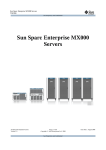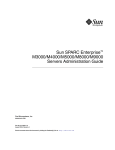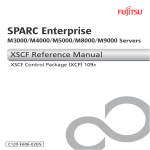Download Siemens SPARC M8000 Installation guide
Transcript
SPARC Enterprise M3000/M4000/M5000/M8000/M9000 Servers Glossary Part No.: E28107-01 Manual Code: C120-E514-05EN March 2012 Copyright © 2007, 2012, Oracle and/or its affiliates and Fujitsu Limited. All rights reserved. Oracle and/or its affiliates and Fujitsu Limited each own or control intellectual property rights relating to products and technology described in this document, and such products, technology and this document are protected by copyright laws, patents, and other intellectual property laws and international treaties. This document and the product and technology to which it pertains are distributed under licenses restricting their use, copying, distribution, and decompilation. No part of such product or technology, or of this document, may be reproduced in any form by any means without prior written authorization of Oracle and/or its affiliates and Fujitsu Limited, and their applicable licensors, if any. The furnishings of this document to you does not give you any rights or licenses, express or implied, with respect to the product or technology to which it pertains, and this document does not contain or represent any commitment of any kind on the part of Oracle or Fujitsu Limited, or any affiliate of either of them. This document and the product and technology described in this document may incorporate third-party intellectual property copyrighted by and/or licensed from the suppliers to Oracle and/or its affiliates and Fujitsu Limited, including software and font technology. Per the terms of the GPL or LGPL, a copy of the source code governed by the GPL or LGPL, as applicable, is available upon request by the End User. Please contact Oracle and/or its affiliates or Fujitsu Limited. This distribution may include materials developed by third parties. Parts of the product may be derived from Berkeley BSD systems, licensed from the University of California. UNIX is a registered trademark in the U.S. and in other countries, exclusively licensed through X/Open Company, Ltd. Oracle and Java are registered trademarks of Oracle and/or its affiliates. Fujitsu and the Fujitsu logo are registered trademarks of Fujitsu Limited. All SPARC trademarks are used under license and are registered trademarks of SPARC International, Inc. in the U.S. and other countries. Products bearing SPARC trademarks are based upon architectures developed by Oracle and/or its affiliates. SPARC64 is a trademark of SPARC International, Inc., used under license by Fujitsu Microelectronics, Inc. and Fujitsu Limited. Other names may be trademarks of their respective owners. United States Government Rights - Commercial use. U.S. Government users are subject to the standard government user license agreements of Oracle and/or its affiliates and Fujitsu Limited and the applicable provisions of the FAR and its supplements. Disclaimer: The only warranties granted by Oracle and Fujitsu Limited, and/or any affiliate of either of them in connection with this document or any product or technology described herein are those expressly set forth in the license agreement pursuant to which the product or technology is provided. EXCEPT AS EXPRESSLY SET FORTH IN SUCH AGREEMENT, ORACLE OR FUJITSU LIMITED, AND/OR THEIR AFFILIATES MAKE NO REPRESENTATIONS OR WARRANTIES OF ANY KIND (EXPRESS OR IMPLIED) REGARDING SUCH PRODUCT OR TECHNOLOGY OR THIS DOCUMENT, WHICH ARE ALL PROVIDED AS IS, AND ALL EXPRESS OR IMPLIED CONDITIONS, REPRESENTATIONS AND WARRANTIES, INCLUDING WITHOUT LIMITATION ANY IMPLIED WARRANTY OF MERCHANTABILITY, FITNESS FOR A PARTICULAR PURPOSE OR NONINFRINGEMENT, ARE DISCLAIMED, EXCEPT TO THE EXTENT THAT SUCH DISCLAIMERS ARE HELD TO BE LEGALLY INVALID. Unless otherwise expressly set forth in such agreement, to the extent allowed by applicable law, in no event shall Oracle or Fujitsu Limited, and/or any of their affiliates have any liability to any third party under any legal theory for any loss of revenues or profits, loss of use or data, or business interruptions, or for any indirect, special, incidental or consequential damages, even if advised of the possibility of such damages. DOCUMENTATION IS PROVIDED “AS IS” AND ALL EXPRESS OR IMPLIED CONDITIONS, REPRESENTATIONS AND WARRANTIES, INCLUDING ANY IMPLIED WARRANTY OF MERCHANTABILITY, FITNESS FOR A PARTICULAR PURPOSE OR NON-INFRINGEMENT, ARE DISCLAIMED, EXCEPT TO THE EXTENT THAT SUCH DISCLAIMERS ARE HELD TO BE LEGALLY INVALID. Please Recycle Copyright © 2007, 2012, Oracle et/ou ses sociétés affiliées et Fujitsu Limited. Tous droits réservés. Oracle et/ou ses sociétés affiliées et Fujitsu Limited détiennent et contrôlent chacune des droits de propriété intellectuelle relatifs aux produits et technologies décrits dans ce document. De même, ces produits, technologies et ce document sont protégés par des lois sur le copyright, des brevets, d’autres lois sur la propriété intellectuelle et des traités internationaux. Ce document, le produit et les technologies afférents sont exclusivement distribués avec des licences qui en restreignent l’utilisation, la copie, la distribution et la décompilation. Aucune partie de ce produit, de ces technologies ou de ce document ne peut être reproduite sous quelque forme que ce soit, par quelque moyen que ce soit, sans l’autorisation écrite préalable d’Oracle et/ou ses sociétés affiliées et de Fujitsu Limited, et de leurs éventuels bailleurs de licence. Ce document, bien qu’il vous ait été fourni, ne vous confère aucun droit et aucune licence, expresses ou tacites, concernant le produit ou la technologie auxquels il se rapporte. Par ailleurs, il ne contient ni ne représente aucun engagement, de quelque type que ce soit, de la part d’Oracle ou de Fujitsu Limited, ou des sociétés affiliées de l’une ou l’autre entité. Ce document, ainsi que les produits et technologies qu’il décrit, peuvent inclure des droits de propriété intellectuelle de parties tierces protégés par copyright et/ou cédés sous licence par des fournisseurs à Oracle et/ou ses sociétés affiliées et Fujitsu Limited, y compris des logiciels et des technologies relatives aux polices de caractères. Conformément aux conditions de la licence GPL ou LGPL, une copie du code source régi par la licence GPL ou LGPL, selon le cas, est disponible sur demande par l’Utilisateur final. Veuillez contacter Oracle et/ou ses sociétés affiliées ou Fujitsu Limited. Cette distribution peut comprendre des composants développés par des parties tierces. Des parties de ce produit peuvent être dérivées des systèmes Berkeley BSD, distribués sous licence par l’Université de Californie. UNIX est une marque déposée aux États-Unis et dans d’autres pays, distribuée exclusivement sous licence par X/Open Company, Ltd. Oracle et Java sont des marques déposées d’Oracle Corporation et/ou de ses sociétés affiliées. Fujitsu et le logo Fujitsu sont des marques déposées de Fujitsu Limited. Toutes les marques SPARC sont utilisées sous licence et sont des marques déposées de SPARC International, Inc., aux États-Unis et dans d’autres pays. Les produits portant la marque SPARC reposent sur des architectures développées par Oracle et/ou ses sociétés affiliées. SPARC64 est une marque de SPARC International, Inc., utilisée sous licence par Fujitsu Microelectronics, Inc. et Fujitsu Limited. Tout autre nom mentionné peut correspondre à des marques appartenant à d’autres propriétaires. United States Government Rights - Commercial use. U.S. Government users are subject to the standard government user license agreements of Oracle and/or its affiliates and Fujitsu Limited and the applicable provisions of the FAR and its supplements. Avis de non-responsabilité : les seules garanties octroyées par Oracle et Fujitsu Limited et/ou toute société affiliée de l’une ou l’autre entité en rapport avec ce document ou tout produit ou toute technologie décrits dans les présentes correspondent aux garanties expressément stipulées dans le contrat de licence régissant le produit ou la technologie fournis. SAUF MENTION CONTRAIRE EXPRESSÉMENT STIPULÉE DANS CE CONTRAT, ORACLE OU FUJITSU LIMITED ET LES SOCIÉTÉS AFFILIÉES À L’UNE OU L’AUTRE ENTITÉ REJETTENT TOUTE REPRÉSENTATION OU TOUTE GARANTIE, QUELLE QU’EN SOIT LA NATURE (EXPRESSE OU IMPLICITE) CONCERNANT CE PRODUIT, CETTE TECHNOLOGIE OU CE DOCUMENT, LESQUELS SONT FOURNIS EN L’ÉTAT. EN OUTRE, TOUTES LES CONDITIONS, REPRÉSENTATIONS ET GARANTIES EXPRESSES OU TACITES, Y COMPRIS NOTAMMENT TOUTE GARANTIE IMPLICITE RELATIVE À LA QUALITÉ MARCHANDE, À L’APTITUDE À UNE UTILISATION PARTICULIÈRE OU À L’ABSENCE DE CONTREFAÇON, SONT EXCLUES, DANS LA MESURE AUTORISÉE PAR LA LOI APPLICABLE. Sauf mention contraire expressément stipulée dans ce contrat, dans la mesure autorisée par la loi applicable, en aucun cas Oracle ou Fujitsu Limited et/ou l’une ou l’autre de leurs sociétés affiliées ne sauraient être tenues responsables envers une quelconque partie tierce, sous quelque théorie juridique que ce soit, de tout manque à gagner ou de perte de profit, de problèmes d’utilisation ou de perte de données, ou d’interruptions d’activités, ou de tout dommage indirect, spécial, secondaire ou consécutif, même si ces entités ont été préalablement informées d’une telle éventualité. LA DOCUMENTATION EST FOURNIE « EN L’ÉTAT » ET TOUTE AUTRE CONDITION, DÉCLARATION ET GARANTIE, EXPRESSE OU TACITE, EST FORMELLEMENT EXCLUE, DANS LA MESURE AUTORISÉE PAR LA LOI EN VIGUEUR, Y COMPRIS NOTAMMENT TOUTE GARANTIE IMPLICITE RELATIVE À LA QUALITÉ MARCHANDE, À L’APTITUDE À UNE UTILISATION PARTICULIÈRE OU À L’ABSENCE DE CONTREFAÇON. Contents Preface Glossary vii Glossary–1 v vi SPARC Enterprise Mx000 Servers Glossary • March 2012 Preface This document defines terms used in the documentation for SPARC Enterprise M3000/M4000/M5000/M8000/M9000 servers from Oracle and Fujitsu. Some references to server names and document names are abbreviated for readability. For example, if you see a reference to the M9000 server, note that the full product name is the SPARC Enterprise M9000 server. And if you see a reference to the XSCF Reference Manual, note that the full document name is the SPARC Enterprise M3000/M4000/M5000/M8000/M9000 Servers XSCF Reference Manual. Before reading this document, you should read the overview guide for your server. At publication of this document, servers described herein were shipping with XCP 1100 firmware installed. That might no longer be the latest available version, or the version now installed. Always see the Product Notes that apply to the firmware on your server, and those that apply to the latest firmware release. This preface includes the following sections: ■ “Audience” on page vii ■ “Related Documentation” on page viii ■ “Text Conventions” on page x ■ “Syntax of the Command-Line Interface (CLI)” on page x ■ “Documentation Feedback” on page xi Audience This guide is written for experienced system administrators with working knowledge of computer networks and advanced knowledge of the Oracle Solaris Operating System (Oracle Solaris OS). vii Related Documentation All documents for your server are available online at the following locations. Documentation Link Sun Oracle software-related manuals (Oracle Solaris OS, and so on) http://www.oracle.com/documentation Fujitsu documents http://www.fujitsu.com/sparcenterprise/manual/ Oracle M-series server documents http://www.oracle.com/technetwork/documentation/spar c-mseries-servers-252709.html The following table lists titles of related documents. Related SPARC Enterprise M3000/M4000/M5000/M8000/M9000 Servers Documents SPARC Enterprise M3000 Server Site Planning Guide SPARC Enterprise M4000/M5000 Servers Site Planning Guide SPARC Enterprise M8000/M9000 Servers Site Planning Guide SPARC Enterprise Equipment Rack Mounting Guide SPARC Enterprise M3000 Server Getting Started Guide* SPARC Enterprise M4000/M5000 Servers Getting Started Guide* SPARC Enterprise M8000/M9000 Servers Getting Started Guide* SPARC Enterprise M3000 Server Overview Guide SPARC Enterprise M4000/M5000 Servers Overview Guide SPARC Enterprise M8000/M9000 Servers Overview Guide SPARC Enterprise M3000/M4000/M5000/M8000/M9000 Servers Important Legal and Safety Information * SPARC Enterprise M3000 Server Safety and Compliance Guide SPARC Enterprise M4000/M5000 Servers Safety and Compliance Guide SPARC Enterprise M8000/M9000 Servers Safety and Compliance Guide External I/O Expansion Unit Safety and Compliance Guide SPARC Enterprise M4000 Server Unpacking Guide* SPARC Enterprise M5000 Server Unpacking Guide* SPARC Enterprise M8000/M9000 Servers Unpacking Guide* SPARC Enterprise M3000 Server Installation Guide viii SPARC Enterprise Mx000 Servers Glossary • March 2012 Related SPARC Enterprise M3000/M4000/M5000/M8000/M9000 Servers Documents SPARC Enterprise M4000/M5000 Servers Installation Guide SPARC Enterprise M8000/M9000 Servers Installation Guide SPARC Enterprise M3000 Server Service Manual SPARC Enterprise M4000/M5000 Servers Service Manual SPARC Enterprise M8000/M9000 Servers Service Manual External I/O Expansion Unit Installation and Service Manual SPARC Enterprise M3000/M4000/M5000/M8000/M9000 Servers Administration Guide SPARC Enterprise M3000/M4000/M5000/M8000/M9000 Servers XSCF User’s Guide SPARC Enterprise M3000/M4000/M5000/M8000/M9000 Servers XSCF Reference Manual SPARC Enterprise M4000/M5000/M8000/M9000 Servers Dynamic Reconfiguration (DR) User’s Guide SPARC Enterprise M4000/M5000/M8000/M9000 Servers Capacity on Demand (COD) User’s Guide SPARC Enterprise M3000/M4000/M5000/M8000/M9000 Servers Product Notes† SPARC Enterprise M3000 Server Product Notes SPARC Enterprise M4000/M5000 Servers Product Notes SPARC Enterprise M8000/M9000 Servers Product Notes External I/O Expansion Unit Product Notes SPARC Enterprise M3000/M4000/M5000/M8000/M9000 Servers Glossary * This is a printed document. † Beginning with the XCP 1100 release. Preface ix Text Conventions This manual uses the following fonts and symbols to express specific types of information. Font/Symbol Meaning Example AaBbCc123 What you type, when contrasted with on-screen computer output. This font represents the example of command input in the frame. XSCF> adduser jsmith AaBbCc123 The names of commands, files, and directories; on-screen computer output. This font represents the example of command output in the frame. XSCF> showuser -P User Name: jsmith Privileges: useradm auditadm Italic Indicates the name of a reference manual, a variable, or userreplaceable text. See the SPARC Enterprise M3000/M4000/M5000/M8000/M9000 Servers XSCF User’s Guide. "" Indicates names of chapters, sections, items, buttons, or menus. See Chapter 2, "System Features." Syntax of the Command-Line Interface (CLI) The command syntax is as follows: x ■ A variable that requires input of a value must be put in Italics. ■ An optional element must be enclosed in []. ■ A group of options for an optional keyword must be enclosed in [] and delimited by |. SPARC Enterprise Mx000 Servers Glossary • March 2012 Documentation Feedback If you have any comments or requests regarding this document, go to the following websites: ■ For Oracle users: http://www.oracle.com/goto/docfeedback Include the title and part number of your document with your feedback: SPARC Enterprise M3000/M4000/M5000/M8000/M9000 Glossary, part number E28107-01 ■ For Fujitsu users: http://www.fujitsu.com/global/contact/computing/sparce_index.html Preface xi xii SPARC Enterprise Mx000 Servers Glossary • March 2012 Glossary A AC Section (ACS) ACS active addition A power supply unit consisting of a power input terminal board, main line switch, etc. See AC Section (ACS). To add a FRU while the domain or server continues running. Active Directory A distributed directory service that provides both authentication of user credentials and authorization of user access level to networked resources. Both Active Directory and LDAP/SSL use authentication to verify the identity of users before they can access system resources, and to grant specific access privileges to users in order to control their rights to access networked resources. active replacement To replace a FRU while the domain or server continues running. Active replacement requires that the FRU be inactivated or powered down using either an XSCF command or a Oracle Solaris OS command. active XSCF add The XSCF that controls the system in a dual-XSCF unit configuration. Also called an active XSCF unit. A term used in Dynamic Reconfiguration to assign or integrate a system board to or into a domain. assign A term used in Dynamic Reconfiguration to assign a system board to a domain. audit To collect data related to the use of system resources. An audit records security-related system events. Glossary-1 audit class audit event audit file A grouping of audit events. Audit classes provide a way to select a group of security-related system events to audit. A security-related system action that is audited. Events are grouped into classes. A log where audit records are stored. audit policy A set of audit options that can be enabled or disabled by the administrator. These options include the option for specifying events to be recorded and the option for specifying whether to record specific types of audit data. They also include the option for specifying whether to stop audit processing when the audit tray is full. audit record Audit data stored in the audit file. One audit record has one audit event. Each audit record consists of audit tokens. audit token One field in an audit record. An audit token contains an audit event attribute, such as user or privilege. audit trail A set of audit logs that have been recorded by the server. The audit trail can be analyzed with the use of audit tools. B Backplane (BP) A circuit board containing a set of sockets to which other circuit boards can be connected. Pins on the backplane sockets are interconnected by printed wire traces. These traces allow components on the connected circuit boards to distribute signals to components on other connected boards. Backplane Unit (BPU) A unit containing sockets used to connect multiple units. In the SPARC Enterprise M4000 server, the BPU consists of a power supply backplane and I/O backplane. In the SPARC Enterprise M5000 server, the BPU consists of a power supply backplane, I/O backplane, and bus bar. BP BPU Browser User Interface (BUI) BUI Glossary-2 See Backplane (BP). See Backplane Unit (BPU). Like a Graphical User Interface (GUI), but accessed through a browser. See Browser User Interface (BUI). SPARC Enterprise Mx000 Servers Glossary • March 2012 C Capacity on Demand (COD) The COD feature allows you to configure spare processing resources on your M4000/M5000/M8000/M9000 server in the form of one or more COD CPUs which can be activated at a later date when additional processing power is needed. The M3000 server does not support COD. To access each COD CPU, you must purchase a COD hardware activation permit. Under certain conditions, you can use COD resources before purchasing COD permits for them. See the SPARC Enterprise M4000/M5000/M8000/M9000 Servers Capacity on Demand (COD) User’s Guide. carrier A component used to mount PCI cards or link cards in the PCI box. The carrier with link cards is also called the link carrier, and the one with PCI cards is also called the PCI carrier. The function is similar to that of the PCI cassette, but is not compatible. CB See Circuit Breaker (CB). CE See Correctable Error (CE). Chassis Serial Number (CSN) Circuit Breaker (CB) CLKU Clock Control Unit (CLKU) CMU CMU Channel (CMU-CH) CMU-CH COD A serial number used to identify a server. The chassis serial number is printed on the label affixed to the front side and right side of the system cabinet. This number is used for the service provider to associate hardware error events and maintenance actions with the relevant server. Used for the SPARC Enterprise M4000/M5000 servers. An external circuit breaker (such as a power distribution board or power distribution box) connecting to an AC cable. The CB is also called a site circuit breaker. See Clock Control Unit (CLKU). The unit for supplying clock signals to the CPU/memory board unit and crossbar unit. The CLKU is mounted only on the SPARC Enterprise M9000 server. See CPU/Memory Board Unit (CMU). The bridge that connects system control devices to the system bus. The CMU channel is mounted on the CMU. SPARC Enterprise M8000/M9000 servers implement the functions for slave operation only, such as SCF interface boot PROM, TTY, and I/O Interrupt. See CMU Channel (CMU-CH). See Capacity on Demand (COD). Glossary-3 cold addition To add a FRU while the server is powered off. During cold addition, all types of FRUs can be added. cold replacement To replace a FRU while the server is powered off. During cold replacement, all types of FRUs can be replaced. configure A term used in Dynamic Reconfiguration (DR) to integrate a system board which has been assigned to the domain’s OS, and put it into a usable state. connect A term used in Dynamic Reconfiguration (DR) to electrically connect an already-mounted system board. Connecting a system board may enable the monitoring of that board. core Correctable Error (CE) See CPU core. A CPU, memory or I/O error that is correctable, usually by simply attempting again the operation (such as a rewrite to memory) that previously failed. CPU chip A physical processor. An LSI chip on which a central processing unit (CPU) is mounted CPU core A segmented processing unit of the CPU chip. A virtual processor. CPU Module (CPUM) CPU/Memory Board Unit (CMU) CPUM A module containing one or two CPU chip(s). A unit consisting of a CPU memory board, memory, and CPU module, used in the SPARC Enterprise M8000/M9000 server. See CPU Module (CPUM). Crossbar (XB) The switch ASIC controlling data transfer between the system controller and I/O unit. Crossbar Unit (XBU) The unit used to logically switch between the CPU/memory board unit and I/O unit. The XBU is mounted only on the SPARC Enterprise M9000 server. D DAT DC-to-DC converter (DDC) Glossary-4 digital audio tape. The component that converts DC input into another voltage level. DCL See Domain Component List (DCL). DDC See DC-to-DC converter (DDC). SPARC Enterprise Mx000 Servers Glossary • March 2012 degraded delete The state of a FRU, group of FRUs, or part of a FRU, that has been isolated because a fault was detected. The isolation is usually done to prevent possibly faulty components from affecting other system components. The part that is isolated is not always the faulty part alone; a normal part may be degraded to isolate the faulty part. If a function required for the operation of the system is degraded, a system failure may result. A term used in Dynamic Reconfiguration to isolate or unassign a system board from a domain. device serial number The serial number assigned to each shipped component, stored in the FRUID PROM. disconnect A term used in Dynamic Reconfiguration to describe electrical disconnection of a system board. Disconnecting a board disables the monitoring of that board. domain A set of one or more system boards that function as an independent system. While the server is shared, an operating system can be installed in each domain to enable each domain to operate as an independent system. Each domain consists of a logical system board assigned to it. Each domain is electrically insulated by each hardware partition. Therefore, if one domain fails, it does not affect the other domains in the server. Domain - SP Communication Protocol (DSCP) The protocol that implements TCP/IP socket type communication (normally performed between user levels) between the service processor and the domain. This communication is performed for the mailbox type communication performed by other software components. Domain Component List (DCL) A list of system boards used to construct each domain Domain ID (DID) downlink card DR DSCP Domain identifier. A link card mounted in the I/O unit. Although this link card is physically the same as the one mounted on the I/O board in the External I/O Expansion Unit, the one mounted in the I/O unit is sometimes called a downlink card. See also link card and uplink card. See Dynamic Reconfiguration (DR). See Domain - SP Communication Protocol (DSCP). dual power feed A type of power feed for high-reliability systems that contain dual power supply lines. If one line stops, the other line enables the system to continue operation. dummy panel/board A panel or board inserted into an unused slot or space. Attaching this panel or board can prevent cooling air in the system from leaking. DVDBP See DVD Backplane (DVDBP). Glossary-5 DVD Backplane (DVDBP) Dynamic Host Configuration Protocol (DHCP) Dynamic Reconfiguration (DR) A backplane for a DVD drive. See also Backplane (BP). Software that automatically assigns IP addresses to clients on a Transmission Control Protocol/Internet Protocol (TCP/IP) network. Software that enables logical attachment and detachment of system boards to and from a domain without having to first power off that domain. DR allows the logical (and, therefore, physical) installation and removal of system boards while the domain’s Oracle Solaris OS continues running. E Entry-level server A SPARC Enterprise M3000 server. equipment rack A rack for mounting a SPARC Enterprise M3000/M4000/M5000 server or an External Expansion I/O Unit. eXtended System Board (XSB) The XSB is made of physical parts. In the XSB, the PSB can be either one complete unit (undivided status) or divided into four subunits. The XSB is a unit used for domain construction and identification, and also can be used as a logical unit. eXtended System Control Facility (XSCF) Firmware running in a service processor. The XSCF is equipped with the control and monitoring functions of the system platform. external I/O expansion unit A rack-mount type device used to add PCI slots to the SPARC Enterprise M3000/M4000/M5000/M8000/M9000 servers. The External I/O Expansion Unit is connected to the I/O unit of the server via the PCI Express bus. It can accommodate up to 12 PCI-X cards or PCI Express cards in units of six cards. Externally Initiated Reset (XIR) To send a reset signal via software to the CPU on the domain. Upon receipt of the reset signal, the domain shifts to the OpenBoot PROM environment and performs processing according to the value set in OpenBoot PROM environment variable error-reset-recovery. Glossary-6 SPARC Enterprise Mx000 Servers Glossary • March 2012 F failover Fan Backplane (FANBP) FANBP Fault Management Architecture (FMA) Field Replaceable Unit (FRU) firmware FRU A process in which the active service processor passes control to the standby service processor or the standby service processor takes over control from the active service processor. In either process, the current standby service processor takes the place of the active service processor and the active service processor takes the place of the standby service processor. The active backplane for the fan. See also Backplane (BP). See Fan Backplane (FANBP). Generates fault indictments from the Service Processor. FMA provides three system activities: error handling, fault diagnosis, and response. A part that can be replaced by field engineers when servicing the server. Software that controls the server. The SPARC Enterprise M3000/M4000/M5000/M8000/M9000 server has the following types of firmware: OpenBoot PROM, Power-On Self-Test (POST), and eXtended System Control Facility (XSCF). Firmware is provided as a package called XSCF Control Package (XCP). See Field Replaceable Unit (FRU). H Hard Disk Drive Backplane (HDDBP) HDD HDDBP head room or headroom The backplane for the disk drive. See also Backplane (BP). A hard disk drive. See Hard Disk Drive Backplane (HDDBP). The capability to use up to four COD CPUs per server without a sufficient number of COD permits to cover their use. Use of headroom, which is synonymous with instant access CPU, is available under certain conditions. See the SPARC Enterprise M4000/M5000/M8000/M9000 Servers Capacity on Demand (COD) User’s Guide. high-end server hot addition hot replacement A SPARC Enterprise M8000/M9000 server. To add a FRU while the domain is powered off. To replace a FRU while the domain is powered off. Glossary-7 I I/O Backplane (IOBP) I/O boat I/O Controller (IOC) The backplane for the I/O device. See also Backplane (BP). A component used to provide an external I/O expansion unit with PCI slots. Two types of I/O boards, a PCI Express (PCIe) I/O board and PCI-X I/O board, are used. One I/O board can add up to six PCI slots. Up to two I/O boards can be mounted in the external I/O expansion unit. A bridge between the system bus and I/O bus (PCI Express (PCIe)) The I/O Controller is connected to the Crossbar (XB) on the SPARC Enterprise M9000 server or to the System Controller (SC) on the SPARC Enterprise M8000 server. I/O Unit (IOU) On SPARC Enterprise M8000/M9000 servers, a unit that can accommodate eight PCIe slots and up to four HDDs. A PCI Express (PCIe) card, internal drive connection card (IOUA), and link card can be inserted into PCIe slots via a PCI cassette. On SPARC Enterprise M4000/M5000 servers, an I/O Unit (IOU) that can accommodate PCI Express (PCIe) and PCI-X cards. PCI cards are first inserted into a PCI cassette and then the PCI cassette is mounted in the I/O Unit. One I/O Unit can accommodate five PCI cassettes, four PCI Express (PCIe) cassettes (upper four slots), and one PCI-X cassette (bottom slot). The mechanism for connecting an internal drive is already mounted, but a link card can be inserted. install instant access CPU Inter SCF Network (ISN) IOBox Synonymous with head room or headroom. A network that communicates between active XSCF and standby XSCF. It is used when XSCF units are in redundant configuration. Synonymous with an external I/O expansion unit. A PCI box may be represented as an external I/O expansion unit in programs and manuals. IOBP See I/O Backplane (IOBP). IOC See I/O Controller (IOC). IOU See I/O Unit (IOU). IOUA IOU Onboard Device Card (IOUA) Glossary-8 A term used in Dynamic Reconfiguration which represents the process of incorporating a system board into a domain. See IOU Onboard Device Card (IOUA). An option for mounting CD-RW/DVD-RW drive units or tape drive units in SPARC Enterprise M4000/M5000/M8000/M9000 server cabinets. SPARC Enterprise Mx000 Servers Glossary • March 2012 ISN See Inter SCF Network (ISN). L LDAP LDAP/SSL Lightweight Directory Access Protocol (LDAP) link cable See Lightweight Directory Access Protocol (LDAP). Offers enhanced security to LDAP users by way of Secure Socket Layer (SSL) technology, using the LDAP directory service to authenticate users. Both Active Directory and LDAP/SSL use authentication to verify the identity of users before they can access system resources, and to grant specific access privileges to users in order to control their rights to access networked resources. Protocol for accessing information directories. LDAP is based on the standards contained within the X.500 standard, but is significantly simpler. An interfacing cable for connecting the link card on the host server to the link card in the external I/O expansion unit. link card An interface card used to connect an I/O Unit (IOU) and the I/O board in the external I/O expansion unit. The link card mounted in the I/O board is also called an uplink card, and the one mounted in the I/O Unit is also called a downlink card. Logical System Board (LSB) A system board assigned a logical number (LSB number) that can be recognized from the domain during domain construction. One domain consists of up to 16 logical system boards. Logical system board numbers are used for the domain to identify the system board. low profile LSB One of the PCI card standards. A low profile card is a compact PCI card which is provided for a host server that has limited space for card slots. See Logical System Board (LSB). M MAC MAC address See Memory Access Controller (MAC). See Media Access Control address (MAC address). Glossary-9 main line switch Management Information Base (MIB) MBU Media Access Control address (MAC address) MEMB Memory Access Controller (MAC) Memory Board (MEMB) MIB midrange server mode switch Motherboard Unit (MBU) move A power switch provided in the SPARC Enterprise M8000/M9000 server cabinet. Turning on or off all main line switches means the same thing as turning on or off an external circuit breaker, such as a distribution panel or power distribution box. Management information database for the SNMP agent function. MIB information is returned in response to a request from the SNMP Manager. See Motherboard Unit (MBU). The worldwide unique serial number assigned to a network interface. IEEE manages distribution of MAC addresses. See Memory Board (MEMB). An ASIC that provides the memory access control function. It performs memory access under the direction of the System Controller ASIC. A board in the SPARC Enterprise M4000/M5000 server on which memory modules are mounted. See Management Information Base (MIB). The SPARC Enterprise M4000/M5000 server. A physical key switch on the server that controls system modes: locked and service. The main board assembly to which other boards and components are connected in SPARC Enterprise M3000/M4000/M5000 servers. SPARC Enterprise M8000/M9000 servers have system boards instead of motherboard assemblies. A term used in Dynamic Reconfiguration, a move is a series of operations that unconfigure a system board from one domain and integrate it into another domain. N Network Time Protocol (NTP) NTP Glossary-10 NTP supports synchronization of Oracle Solaris OS time with the time service provided by a remote host. See Network Time Protocol (NTP). SPARC Enterprise Mx000 Servers Glossary • March 2012 O OpenBoot PROM Operator Panel (OPNL) Oracle Solaris OS A layer of software that takes control of the configured server from Power-On Self-Test (POST), builds some data structures in memory, and boots the operating system. OpenBoot PROM is compliant with IEEE 1275. A panel containing the LEDs that indicate the condition of the server and the settings of the POWER and mode switches. The Oracle Solaris operating system, which controls and manages the domains. P password policy A set of rules for the creation and maintenance of passwords. PCI carrier A component used to mount PCI cards in the external I/O expansion unit. The PCI carrier has a similar function to the PCI cassette used for the SPARC Enterprise M4000/M5000/M8000/M9000 servers. The PCI carrier, however, is not compatible with the PCI cassette. See also carrier. PCI cassette A component used to mount PCI Express (PCIe) cards in an I/O Unit (IOU) of a SPARC Enterprise M4000/M5000/M8000/M9000 server. PCI Express (PCIe) PCI Hot Plug (PHP) PCIe PCIe slot PCI-X PHP A high-speed serial transfer interface. The minimum configuration of the PCIe transmission line is called a lane. The ports of SPARC Enterprise M4000/M5000/M8000/M9000 servers consist of eight lanes (x8). PCIe supports hot plugging. Active addition or removal of a PCI card executed during Oracle Solaris OS operation. See PCI Express (PCIe). A high-speed serial point-to-point interconnect. The minimum configuration of the PCIe transmission line is called a lane. A PCIe slot of the SPARC Enterprise M3000 server consists of eight lanes (x8) of PCI Express bus. Compared with PCI-X, the PCIe data transfer rates are doubled. A faster version of the parallel bus PCI standard. The PCI-X bus has improved protocols and a faster clock rate. See PCI Hot Plug (PHP). Glossary-11 Physical System Board (PSB) POST Power Supply Unit (PSU) Power-On Self-Test (POST) PSB PSB division type PSU PSU Backplane (PSUBP) PSUBP A board consisting of physical parts, such as one CMU and one I/O Unit (IOU), or one CMU. In the SPARC Enterprise M4000/M5000 server, a CMU is mounted on an MBU. The PSB may be used to indicate physical units for hardware addition, removal, or replacement. The PSB is used as one unit (not divided) or four divided units. See Power-On Self-Test (POST). A unit that inputs AC power and outputs several types of voltage. A diagnostic test that is automatically executed when the server is powered on. POST checks memory, disks, and other hardware components for errors and then passes control to OpenBoot PROM. See Physical System Board (PSB). The setting for system board segmentation, either Uni-XSB or Quad-XSB. See Power Supply Unit (PSU). The backplane for the power supply unit. See also Backplane (BP). See PSU Backplane (PSUBP). Q Quad-XSB One of the PSB division types. A PSB that is logically divided into four is called Quad-XSB. Quad-XSB is used to explain the PSB division type or status. R Glossary-12 register A term used in Dynamic Reconfiguration to register system boards in the Domain Component List (DCL) release A term used in Dynamic Reconfiguration to release the registration of a system board from the Domain Component List (DCL). remove A term used in Dynamic Reconfiguration to remove a system board. replace A term used in Dynamic Reconfiguration to remove and replace a system board. reserve A term used in Dynamic Reconfiguration to reserve a system board such that it will be added or deleted the next time the domain is powered on. SPARC Enterprise Mx000 Servers Glossary • March 2012 S SC Secure Shell (SSH) service processor See System Controller (SC). A software program that allows the user to log into another server over a network, to execute commands on a remote machine, and to move files from one machine to another. It provides strong authentication and secure communications over insecure channels. A processor that is specifically provided for system controlling and monitoring. XSCF firmware is installed on the service processor. Simple Mail Transfer Protocol (SMTP) A protocol for sending electronic mail through the Internet or an intranet. SMTP is used when email is sent between mail servers or when the client sends email to a mail server. Simple Network Management Protocol (SNMP) A query, command, and response protocol to examine and change configuration parameters of LAN-connected and WAN-connected repeaters, bridges, routers, switches, and other devices connected to a network. SMTP See Simple Mail Transfer Protocol (SMTP). SNMP See Simple Network Management Protocol (SNMP). SSH Solaris OS SSH See Secure Shell (SSH). The Oracle Solaris operating system, which controls and manages the domains. See Secure Shell (SSH). Standby XSCF The XSCF Unit (XSCFU) operating as the backup of the active XSCF Unit in a dual-XSCF Unit configuration. Also called the Standby XSCF Unit. standby-power The power that sustains the power supply even after server power-off. Used to enable the power control system to work. Usually, the eXtended System Control Facility (XSCF) and the power supply control device operate on a standby power supply. system board In the SPARC Enterprise M8000/M9000 server, a system board consists of a CPU and memory on the CPU/Memory Board Unit (CMU) and I/O devices in the I/O Unit (IOU). In the SPARC Enterprise M4000/M5000 server, a system board consists of a CPU module and memory board on the Motherboard Unit (MBU) and I/O devices in the I/O Unit (IOU). The system board is classified into two types, PSB and XSB, depending on the configuration. In the SPARC Enterprise 3000 server, a system board consists of a CPU and memory on the Motherboard Unit (MBU) and PCIe cards on the PCIe slot. system control network A network that connects the XSCF Unit (XSCFU) to the administration console for the system administrator's use. Glossary-13 System Controller (SC) A bridge ASIC that connects the CPU, memory, and I/O. It also controls cache coherency. T Tape Drive Backplane (TAPEBP) The backplane for a tape drive unit. See also Backplane (BP). tape drive unit A tape device used to read data stored on magnetic tape, or write data to it. thread The minimum unit of hardware in the CPU core or multi-threading CPU chip that can be recognized by the software, TTY-bus The serial bus to bridge the console path data between the CMU and XSCF. U UE unassign unconfigure Uncorrectable Error (UE) See Uncorrectable Error (UE). A term used in Dynamic Reconfiguration to release a system board that is assigned to a domain. A term used in Dynamic Reconfiguration to isolate a system board that has previously been integrated into the OS of a domain and putting the system board in the assigned or unassigned state. An uncorrectable memory error, such as a DIMM multi-bit error. Uni-XSB One of the PSB division types. A PSB that logically consists of only one unit (undivided state) is called a Uni-XSB. Uni-XSB is the initial value before division types are defined for a PSB. Uni-XSB is used to explain the PSB division type or status. Uninterruptible Power Supply (UPS) A unit that ensures a stable supply of power to the system in the event of a power failure or an extensive power interruption. UPS cable A cable that connects the UPS Controller (UPC) port and the UPC interface on UPS. UPS Controller (UPC) A device that controls the Uninterruptible Power Supply (UPS). UPS Controller (UPC) port A receiving port on the server to connect an Uninterruptible Power Supply (UPS). Glossary-14 SPARC Enterprise Mx000 Servers Glossary • March 2012 UPC interface on UPS uplink card An interface of the Uninterruptible Power Supply (UPS) to connect to the server A link card mounted on the I/O board in an external I/O expansion unit. Although the uplink card is physically the same card as the link card mounted in an I/O unit, the one mounted on the I/O board is sometimes called an uplink card. See also link card and downlink card. user accounts This term refers to the relationship established between a user and a server, network or information service. User accounts include the information a user needs to log in and use a server. user network A network through which the user can access the system via either the LAN card or the IOU Onboard Device Card_A (IOUA) mounted in the I/O Unit (IOU). user privileges Access privileges granted to users. Depending on the granted privilege, there are restrictions on operations that can be executed for the entire system or domain. User privileges are: useradm, platadm, platop, domainadm, domainmgr, domainop, auditadm, auditop, fieldeng, and none. For more information, see the SPARC Enterprise M3000/M4000/M5000/M8000/M9000 Servers XSCF User’s Guide. X way XB The unit of measurement that indicates the number of CPUs. For example, 4-way or 16-way. See Crossbar (XB). XBU See Crossbar Unit (XBU). XCP See XSCF Control Package (XCP). XSCF Control Package (XCP) The firmware that runs on the service processor and includes XSCF, POST, and OpenBoot PROM firmware. XIR See Externally Initiated Reset (XIR). XSB See eXtended System Board (XSB). XSCF XSCF shell See eXtended System Control Facility (XSCF). The Command Line Interface (CLI) function of XSCF. By entering commands on the shell terminal with which you log in to XSCF, you can execute a variety of settings and displays of this system. Glossary-15 XSCF Unit (XSCFU) XSCF Web XSCFU Glossary-16 A unit that runs with an independent processor. The eXtended System Control Facility (XSCF), which is firmware that has the system management function of the server, is installed in the processor. The Browser User Interface (BUI) function of XSCF. By selecting items of the Web browser with which you log in to XSCF, you can execute a variety of settings and displays of this system. See XSCF Unit (XSCFU). SPARC Enterprise Mx000 Servers Glossary • March 2012






































